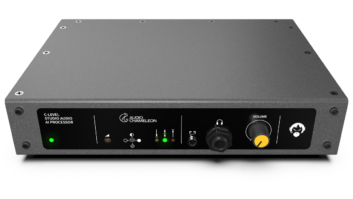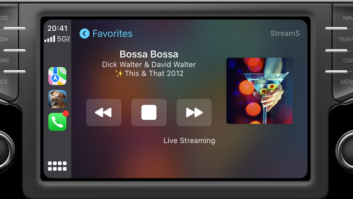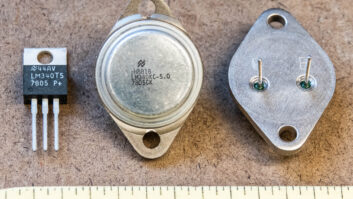How you encode a station for digital radio � whether it�s DAB or another digital output � can make a real difference; and many stations have to deal with bitrates that are lower than they�d like.
Richard Morris, a consulting engineer and digital radio specialist with experience in Australia and the UK, says that filtering the audio before the signal is encoded can be beneficial, since it can make it easier for the encoder to do a good job.
�For UK DAB back in 2000, we noted that the output of the most commonly-used encoder only went up to about 13 KHz when set to 128 kbits joint stereo, so it made sense to filter off anything above this,� Morris told me on email. Morris added: �It�s very obvious, but if your source is stereo but your broadcast channel is mono, you should apply dynamic compression to a mono-ised feed, too.�
UK DAB has historically used �original� DAB, MPEG-1 Layer II, which is increasingly out-moded across the rest of the world. The UK is also one of the most bitrate-starved digital radio environments in the world, with commercial pressures of cost and availability meaning many stations have to make-do with less than ideal transmission bitrates. Ken Rayner (shown above), a freelance radio technologist, was given the task of taking the radio station Jazz FM onto national DAB, in just 32 kbps of data.
The option to use DAB+, which uses the HE-AAC v2 codec, was a tradeoff that allowed the station to gain access to the national airwaves, while potentially losing some potential listeners with old DAB sets that weren�t able to decode DAB+.
Rayner tested the audio during the multiplex�s test transmission period in February 2016. �No amount of encoded audio samples can prepare you for the actual broadcast product in a range of environments. We tested a wide range of music on a wide range of receiving devices both in car, in premises and on personal sets. What we have is a compromise, in a way, but a compromise that seems to keep everyone not unhappy.�
Jazz is a difficult genre to encode, and it was a bit of a risk, Rayner admitted to me via email, to specify SBR and parametric stereo from the outset.
The most important learning was to handle the audio for DAB+ differently. Jazz FM is also broadcast on satellite television and online; in spite of the name, it doesn�t currently have an FM outlet. For DAB+, they use a separate mix from the transmission router, and a dedicated set of audio processors, because Rayner identified that listeners on DAB+ are in specific environments. �We specifically haven’t aimed this at the audience who want to listen to the station on their lovely �2k/�5k/�100k home audio system. They can get a better audio quality from using one of the online streams. Instead, we focused on mobile listeners, in car, on personal sets and in noisy environments like kitchens and workplaces.�
�For processing, we flip between a Broadcast Warehouse DSP-mini HD running an amended “easy listening” preset, and an Optimod 6300 with essentially the same settings. At various times I’m been happier with the sound from one or the other. The truth is that they are just as good as each other for us.�
�Limiting is kept to an absolute minimum,� Rayner adds. �We really let the music breathe. And we make sure the AGC isn�t working too hard either. We also don’t over-emphasise the highs – we have a lot of sibilant, higher register notes � SBR can make it sound very tiresome if the source material is over processed.�
�As the compression techniques used in the DAB+ encoder can mean an increase in the peak level of the decoded signal, we limit the audio from the processor to -4dBFS. In practice, we’ve actually backed it off a little from that as well to allow plenty of headroom for the encoder to work. It’s resulted in a comparatively slightly quieter audio output from receivers � but only very slightly. We’ve traded the possibility of distortion for output loudness and I think we’re pretty happy with the balance we’ve achieved.�
�I think our biggest successes have come from work outside the processor. Making sure the audio isn’t being driven too hard; (obviously) ensuring the source audio is linear PCM; choosing the right flavor of AAC for the bitrate and testing on a wide range of devices outside of a radio studio have all been key.�
Richard Morris also cautions about over-compressing the output. �FM coverage area is limited by when the FM hiss becomes objectionable: so by increasing the loudness, you mask the hiss more, so your signal is listenable to from further away. This is not true for DAB, as coverage is limited by bit error rate and not loudness, so it removes one of the pressures to limit dynamic range.�
Indeed, in 2012, Norwegian broadcasters agreed to h armonise loudness to -15 LUFS. While that�s a higher level than the -23 LUFS laid-down by the EBU�s R128 and the ATSC A/85 recommendations, it ensures that all stations in the country are the same loudness: and has, for one country at least, ended the loudness war.
What�s clear is that digital radio requires specific expertise and thought when it comes to the encoding stage: and time to be taken to test the results. The half-million weekly listeners to Jazz FM in the UK are glad for it.












